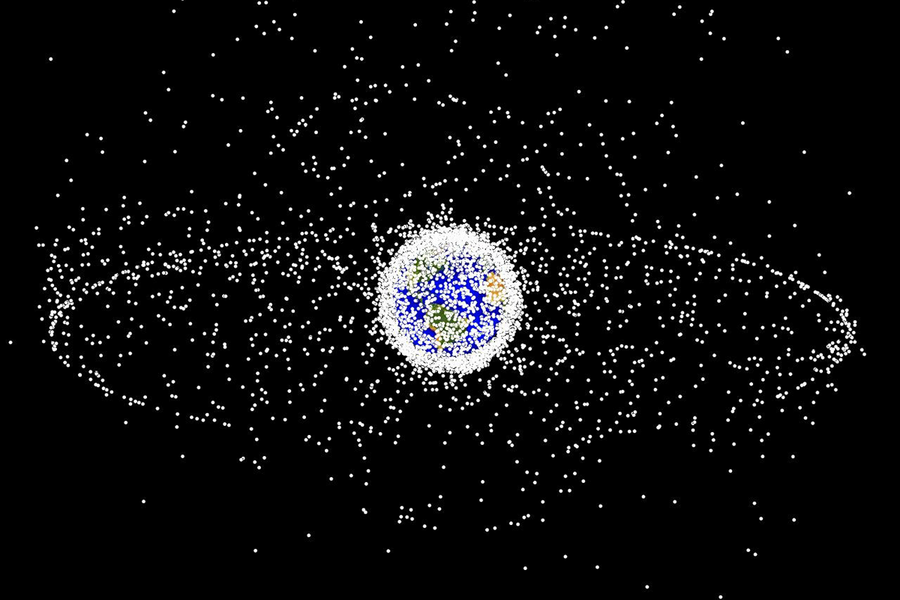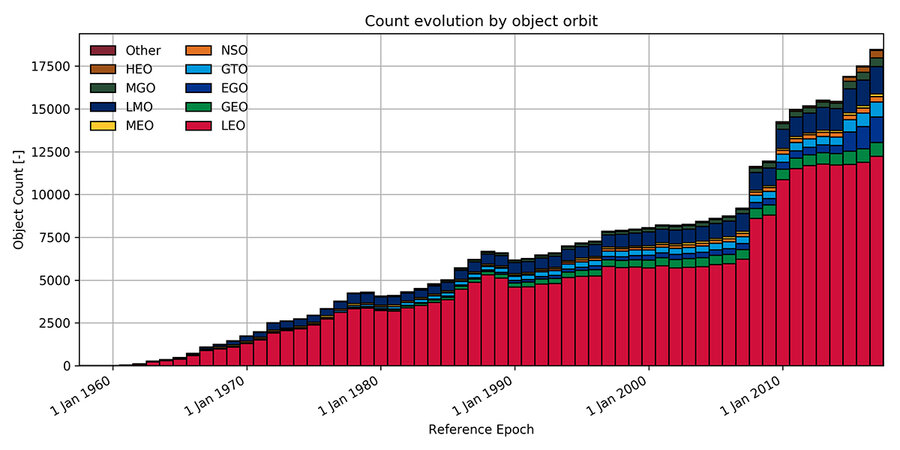As space junk soars, science turns to nature for ideas
Loading...
It was satellites that launched the space age, and it’s satellites that could bring it all crashing down.
More than 1,300 circle above our heads, providing navigation signals, studying the planet, and beaming TV to millions. Few communications pass directly through space networks, but if not for the nearly three dozen atomic clocks providing reliably precise timestamps to anyone with an antenna, financial markets and cell service would quickly fall apart.
It doesn’t take much to reduce these finely tuned machines to thousand-pound wrecks. With life expectancies rarely exceeding a decade, the engineering marvels are surprisingly disposable. And as new arrivals and old relics crowd the useful, near-Earth orbits, governments and researchers seek ways to restore space’s once infinite promise. A smorgasbord of proposals includes slowing the depleted spacecraft with ground-based lasers so that they fall to a fiery end, and flinging them down directly with sling shots, nets, and whips. As yet, though, no one’s reaching for the checkbook.
“Everybody recognizes that this is a problem, and that the problem is getting worse, but it’s not clear exactly whose job it is to clean it up,” says Jet Propulsion Laboratory (JPL) robotics researcher Aaron Parness.
Now, a collaboration between Dr. Parness’s JPL group and a team of Stanford engineers suggests this man-made problem might have a nature-inspired solution: gecko-like pads sticky enough to grab objects in the harsh vacuum of space.
Orbital minefield
What goes up must come down, unless it’s traveling more than 25,000 miles per hour. Of those objects that make it into orbit, air resistance eventually drags down most, but some trajectories can keep others whizzing around for decades.
The Department of Defense catalogs tens of thousands of artificial objects around Earth, but fragments too small to track likely number in the millions. Any one of these hyper-speed projectiles could cause impact damage ranging from divots to explosions.
One big target is the International Space Station, which routinely takes hits from sub-millimeter sized particles and actively dodges larger bits multiple times each year.
And smaller spacecraft are in danger too. In 2009, a US commercial satellite tore through a Russian military satellite, each bursting into a debris cloud that encircled the planet.
Statistical analyses predict these crashes every five to ten years, suggesting the tipping point at which satellite shards destroy other satellites faster than the atmosphere can swallow them up has already passed. NASA astrophysicist Donald Kessler first analyzed this phenomenon, now called the Kessler Syndrome, nearly 40 years ago, and predicted that the emergence of a “debris belt” around Earth could someday halt space activity.
Fortunately, we won’t lose GPS and weather forecasting overnight.
“That’s a popular misconception, that something will trigger it,” Dr. Kessler explains. “It’s more like a very slow chain reaction that plays out over tens of years.”
Focus on 'the big stuff'
NASA’s Orbital Debris Program Office predicts the amount of softball-sized space junk to double within two centuries. Right now, collisions occur once every 10 years or so. But, as Kessler points out, such rare events don’t strictly abide by expected averages: “There’s a significant probability that you could have four collisions within ten years, or you could have none.”
And even one extra breakup makes a huge difference. Two events, the 2009 collision and a 2007 Chinese anti-satellite weapons test, account for more than a quarter of the currently tracked fragments.
Retrieving such shards is nearly impossible, leaving only one practical solution. “Get rid of the big stuff. Get rid of the source,” Kessler urges.
Space agencies have a narrow window in which to act, and they’re trying – to some extent, at least. NASA has almost completely put a stop to spent rocket explosions, once the largest debris source.
Thirteen agencies joined together to form the Inter-Agency Space Debris Coordination Committee (IADC) in 1993, which issues disposal guidelines for satellites. But these are suggestions rather than requirements, and compliance varies.
“The European Space Agency is very strict at enforcing their guidelines,” Kessler says. But since NASA often grants US satellites exemptions, “the US has not been doing very well.”
The good news is, when it comes to active cleanup, some well-placed prevention could be worth thousands and thousands of cures.
Sticking points
The splintering nature of collisions means preventing even a few can significantly slow fragment growth.
NASA simulations estimate removing just two high-risk satellites per year starting in 2020 could halve the two-century growth rate; removing five could stabilize the debris cloud at current levels.
But first engineers have to overcome at least two technical hurdles. The typical defunct satellite is spinning rapidly, and lacks handles to latch onto. Any would-be space trash collector has to be able to stop the object, and then grab it.
While some engineers focus on challenging-to-control harpoons and nets, a Stanford–JPL collaboration takes inspiration from some of nature’s best climbers to solve the latter with a new adhesion system, featured Wednesday in the journal Science.
Most sticky mechanisms break down in extreme vacuums, but geckos exploit quantum weirdness to create a friction-like force between micro hairs on their feet and smooth surfaces. The team’s grabber mimics that behavior, resulting in a device that can grip and release a variety of shapes without pushing them away.
But deorbiting satellites is an expensive business, and Kessler worries too much focus falls on selling concepts rather than buying them. With private aerospace companies and the diminutive “cubesats” driving down the cost of space access, sharing cleanup fees has never been more feasible.
“All you need is something like a 5 percent or 10 percent tax on each launch,” he says. No country has agreed to such a fee so far.
Parness suggests the murky legal status of space complicates cleanup too. “If there’s a Chinese satellite or a satellite from the Soviet Union and NASA goes up there and pulls on it, right now that would break international law,” he explains. It’s every country for themselves.
For now, he looks forward to testing the gecko gripper outside the ISS, and eventually collaborating with satellite servicing missions and private cubesat projects on strategies to address the space trash problem more directly.
“We’re building the technology so that whenever the decision makers decide ‘it’s time,’ we’ll be ready to go,” Parness says.







